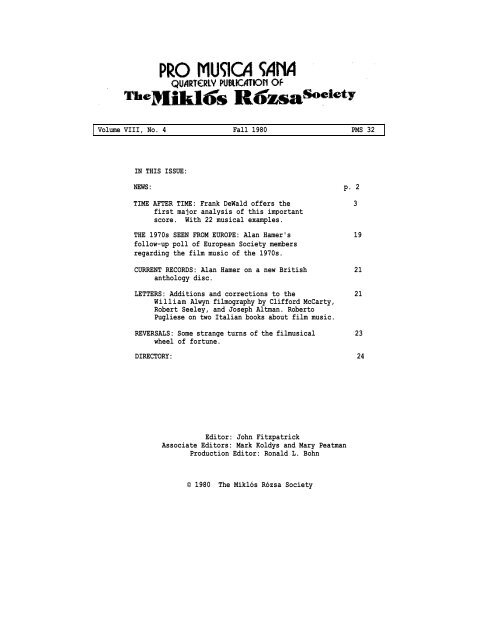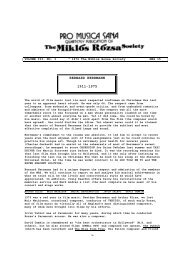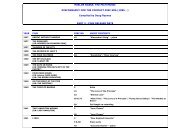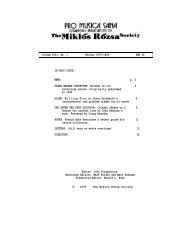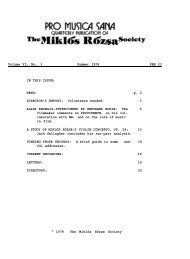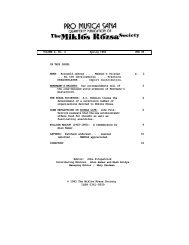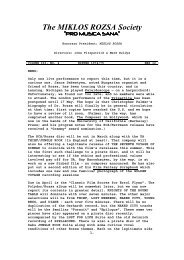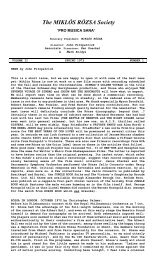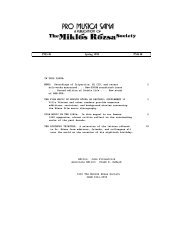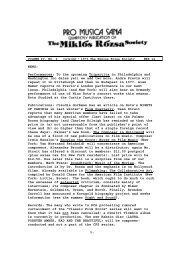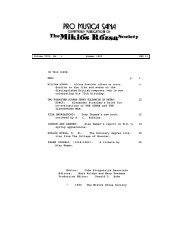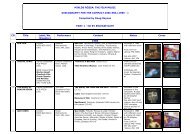Volume VIII, No. 4 Fall 1980 PMS 32 IN THIS ISSUE: NEWS: p. 2 ...
Volume VIII, No. 4 Fall 1980 PMS 32 IN THIS ISSUE: NEWS: p. 2 ...
Volume VIII, No. 4 Fall 1980 PMS 32 IN THIS ISSUE: NEWS: p. 2 ...
You also want an ePaper? Increase the reach of your titles
YUMPU automatically turns print PDFs into web optimized ePapers that Google loves.
<strong>Volume</strong> <strong>VIII</strong>, <strong>No</strong>. 4 <strong>Fall</strong> <strong>1980</strong> <strong>PMS</strong> <strong>32</strong><strong>IN</strong> <strong>THIS</strong> <strong>ISSUE</strong>:<strong>NEWS</strong>: p. 2TIME AFTER TIME: Frank DeWald offers the 3first major analysis of this importantscore. With 22 musical examples.THE 1970s SEEN FROM EUROPE: Alan Hamer's 19follow-up poll of European Society membersregarding the film music of the 1970s.CURRENT RECORDS: Alan Hamer on a new British 21anthology disc.LETTERS: Additions and corrections to the 21William Alwyn filmography by Clifford McCarty,Robert Seeley, and Joseph Altman. RobertoPugliese on two Italian books about film music.REVERSALS: Some strange turns of the filmusical 23wheel of fortune.DIRECTORY: 24Editor: John FitzpatrickAssociate Editors: Mark Koldys and Mary PeatmanProduction Editor: Ronald L. Bohn© <strong>1980</strong> The Miklós Rózsa Society
<strong>NEWS</strong> [December <strong>1980</strong>]:Films:Miklós Rózsa records his EYE OF THE NEEDLE score in London in late January.The film ought to be a spring or summer release.Jerry Goldsmith, who has not been heard from for an entire year following hisproblem-ridden ALIEN and STAR TREK experiences, will be represented shortly byTHE F<strong>IN</strong>AL CONFLICT (the last, we hope, of the OMEN series), OUTLAND, and perhapsTHE SALAMANDER. MASADA, a major television production about the Roman siege ofthe Jewish stronghold, will also be seen this spring.Abel Gance's NAPOLEON, first released in 1926 and under revision or reconstructionever since, will be shown in its original large-screen format this winter underthe auspices of Francis Ford Coppola. In New York the film is booked into RadioCity Music Hall, with a live accompaniment to be provided by the American SymphonyOrchestra. Carmine Coppola is credited with assembling the score. The originalNAPOLEON score, of course, was by Arthur Honegger, whose film music has beensurprisingly and completely neglected even during the recent boom years for themedium. The scores survive today in the Bibliotheque Nationale of Paris. Theydeserve to be investigated.Publications:The early issues of Soundtrack! (formerly SCN) have become collector's items, butnow the best contents of the first 12 numbers have been made available in a 155-pagebooklet called Motion Picture Music. The familiar mix of interviews, recordreviews, and film/discographies (here brought up to date) makes for a valuable,densely packed volume, and editor Luc Van de Ven has wisely included most of thework of SCN's best critic, W. F. Krasnoborski, who unfortunately has not been heardfrom in the more recent issues of the magazine. Some new material has been addedespecially for this collection, most notably filmographies for Les Baxter,Bronislau Kaper, and Bernard Herrmann, the last including more of that composer'stelevision music than has ever been listed before. Motion Picture Music isavailable in the U.S. for $7 from Soundtrack I, P.O. Box 3895, Springfield, MA01101.Recordings:The Varese-Sarabande K<strong>IN</strong>G OF K<strong>IN</strong>GS album (VC 81104; originally issued as WideScreen Spectaculars on Audio Fidelity) is being reissued as a dbx-encoded disc(DBX 81104), to be played through a dbx-decoder. (Scrambled format makes playwithout the decoder almost unlistenable.) The cost for the disc will be about $12and it should be available through the audiophile section of retail stores, orit may be ordered directly from: dbx Inc., 71 Chapel St., Newton, MA 02195.Members who are interested in getting other Rózsa discs issued in the dbx-encodedformat are urged to send their suggestions to Mr. Jerry Ruzicka, Vice Presidentof dbx Inc.<strong>No</strong>w in preparation by Varese is More music from KNIGHTS OF THE ROUND TABLE,which will be available in late spring or early summer.Scores:British distribution of Miklós Rózsa's concert scores (at least those publishedby Breitkopf und Hartel) has been taken over by Kalmus/Universal(continued on page 24)-2-
TIME AFTER TIMEAN ANALYSIS by Frank DeWald:I began work on this article while pursuing doctoral studies in conducting atMichigan State University. When I happened to mention the subject of the articleto a classmate, I met with this incredulous remark: "A film-score?! Whateverfor?" Whatever for, indeed! Why bother to analyze TIME AFTER TIME? Most readersof Pro Musica Sana are, after all, already champions of Miklós Rózsa's music; theydo not need to beconvinced of the composer's talent or skill. The greater musicalpublic which might benefit from an introduction to Rózsa's music will not readthisarticle. So, the question remains: Why? Granted, my classmate's sarcasticremark was prompted by a condescending streak of prejudice against "movie music"that I encounter, sad to say, in virtually all of my musician friends. But it wasa legitimate question and prompted me to these reflections.Music is an intricate art. When it is combined with other arts, as in ballet,opera, and filmusic, its intricacies increase. A 45-minute filmscore comprisingnumerous themes and motives, subtly interrelated and interwoven, is asophisticated creation. <strong>No</strong> superficial hearing can plumb its depths, and evencarefully detailed study only leads to the discovery that there is always more tolearn and appreciate about the composer's work. Indeed, it was the tantalizingprospect of uncovering delightful but unsuspected bits of musical detail thatcaused me to surrender precious hours to the spell of Rózsa's score in the firstplace.Thus, my ultimate reason for writing this article is to increase the enjoyment ofeveryone who listens to TIME AFTER TIME, whether as a film or on discs, by sheddingsome light on the composer's skill. The creation (and subsequent use) of thematicmaterial is Rózsa's forte, and a close look at TIME AFTER TIME reveals three fullthemes and several subsidiary motives woven together into a complex musicalfabric. There are so many subtle interrelationships in the score that it isimpossible to catalog them all, and we can only mention here some of the mostobvious examples. While I will certainly try not to be too technical, I cannotavoid the use of musical terminology and examples, and I beg the indulgence ofthose readers who are put off by such professional matters. I hasten to assurethem that Rózsa's music always looks good under the technical microscope, and thatsuch kinds of analysis are, alas, the only way to convince some stubborn"musicians" of the inherent value in any musical work. (Antoine de Saint-Exuperymissed a golden opportunity: his Little Prince should have visited a planetoccupied by a musical pedant who is too busy analyzing diminished sevenths andGerman sixths to hear the beauty in music!)TIME AFTER TIME is a well-made, witty, and sophisticated film, to which Rózsa'smusic is perfectly suited. The recording, editing, and dubbing of the sound trackhave been accomplished with better-than-usual care. The score itself, althoughless rich in thematic material than some of the composer's more ambitiouscreations, is thoughtfully developed and expertly crafted. It breaks no newground in musical, technical, or dramatic matters, but it is written with thesureness of a technique honed to perfection by the sensitivity, creativity, andexperience of the composer.In this analysis I will discuss each cue (except for source music) as it occursin the film, presenting the themes and motives in the order in which they are heardand subsequently developed. While it might have been more clever to find adifferent way of approaching the score, this is, after-3-
all, the way in which the music evolves for the listener, and should therefore bean easy-to-follow, meaningful organization.The Prelude serves the function of a good main title by establishing a mood forthe story which follows—a grandiose adventure tinged with mystery and romance.We could describe the Prelude in such nonspecific terms as epic, sweeping, andexciting, but I want to analyze it in musical terms so that Rózsa's compositionaltechnique can be appreciated and certain misconceptions possibly created by PageCook's "analysis" in Films in Review (<strong>No</strong>vember 1979) can be clarified.The use of Max Steiner's Warner Brothers fanfare (director Nicholas Meyer'sidea) hasn't pleased everybody, but Rózsa adds his own unique touch: where we mightexpect a resolution in E major, we find the Prelude beginning in E-flat majorinstead. (<strong>No</strong>te: Keys indicated in this article are, whenever possible, based onthe Entr'acte recording [ERS 6517]. For some reason, my tape of the actual filmsound track is a half-step lower.) The texture of the Prelude is basicallytwo-part, with the bass line always closely related to the soprano, as shown inEx. 1. The phrases are grouped into three larger sections, called periods, asfollows:Period 1 (mm. 1-6): 1st phrase (mm. 1-2)2nd phrase (mm. 3-4)3rd phrase (mm. 5-6)Period 2 (mm. 6-9) 1st phrase (m. 6)2nd phrase Cm. 7)3rd phrase (mm. 8- 9)Period 3 (mm. 10-15)1st phrase (m. 10) 2ndphrase (m. 11) 3rdphrase (mm. 12-13)The principal motive is harmonizeddifferently in each period, most strikinglyin period 3, where its initial noteis heard at the top of a mildly dissonantmajor seventh chord (right).The contrary motion of the two voices is worth noting (this is one of the basicrules of good counterpoint), as is the virtual exchange of parts between sopranoand bass in measure 5, beats 6 and 7. The theme is also treated as a round (in period2, measures 6 and 7), a developmental device which Rózsa uses later in thescoreas well.The most important musical device to note before going on is the prominenceof the interval called the tritone. The tritone (e.g., c—f-sharp) is an"unstable" interval because it wants to resolve itself outward to a perfectfifth (c—g) or inward to a perfect fourth (c—f-natural), Rózsa uses it oftento depict menace (e.g., in the last two notes of the famous "Dragnet" motivefrom THE KILLERS), and Rózsa enthusiasts are probably familiar with its nicknameof "diabolus in musica." (See <strong>PMS</strong> 11, p. 10, for a discussion of its use inBEN-HUR.) The tritone will figure prominently in virtually every motive ofTIME AFTER TIME; it is consequently a strong but subtle unifying device.-4-
The next musical cue underscores the approach of the Ripper to his first victim.The "Ripper Theme" (Ex. 2), rife with tritones, will permeate the score. It beginsquietly and low, then rises in pitch and dynamic level to create a terrifyingtension broken, not as we expect by some bloody murder, but by the Ripper'snonchalant greeting. It is old-fashioned stuff that works every bit as welltodayas it ever did. The serpentine shape of the motive, with its slow, insinuating,upward-striving movement, forms a remarkable parallel to the on-screen viperpreparing to strike.As Wells unveils plans for the time machine to friends in his London flat, Rózsaintroduces two very important motives, associated mostly with H.G., in a subtleorchestration of clarinet, string tremolo, and pizzicato basses (Exx. 3 and 4).These motives will reappear frequently in various guises throughout the score.<strong>No</strong>te the two tritones in Ex. 3 (although it is most often heard without the firstone). <strong>No</strong>te also that the rhythm of Ex. 4 corresponds exactly to measure 8 of thePrelude. The low-key, almost subconscious way in which these significant motivesare initiated is in keeping with the character of the scene and even of H.G. himself(the first few pizzicato notes in the bass match his footsteps as he crosses theroom!).The motive coupled with the vaporizing equalizer (Ex. 5), first heard as H.G.describes the device's function, is an "isolated" motive, i.e., it is heard onlywith direct reference to the object it "represents" and is never developed orcombined with other motives. What relates it so strongly to the rest of the scoreis the ever-recurring tritone. The principal elements of its eerie orchestralbackground are string harmonics and celeste.A terse, agitated motive, with a prominent tritone, is heard when the Ripper's bagis discovered in H.G.'s hall closet (Ex. 6). This motive is repeated and thendeveloped as the music comes to the foreground, enhancing the excitement generatedby bustling policemen in search of the Ripper. A second motive (Ex. 7), again witha tritone, is introduced when the dialogue resumes, and although "kept under" onthe sound track, can be heard to full advantage just before the end of "Search forthe Ripper" on the Entr'acte recording. An interesting musical feature of thismotive is the overlapping of melodic "cells" (a and b) with rhythmic ones (c and d).The cue ends with the Ripper theme as H.G. stands looking puzzled in his ront fhall.When H.G. first realizes how his invention may have been misused by Stevenson, herushes to his laboratory to find his worst fears confirmed. His heavy tread downthe stairs is harmonized by the music--a marvelously intent, soulful rendition ofthe time machine theme (i.e., the Prelude), which in partnership with MalcolmMacDowell's fine acting eloquently bespeaks H.G.'s despair at the realization ofwhat he is responsible for. A tiny little motive (Ex. 8) is here attached as apick-up to the time machine theme. It will appear later in the same function andalso on its own.As the time machine materializes before H.G.'s eyes, the music becomes insistentlystiff and mechanical, as if to mock the preceding emotional moment (Ex. 9). Thetritone is, of course, an important part of this motive, and in fact we find herea very close relation to THE KILLERS (Ex. 10). The serpentine shape of thismotive--a series of intervals striving upward but always seeming to fall back onthe same note--relates it in a subtle way to the Ripper theme and, perhaps moreobviously, to other motives that will appear later in the score. For some reason,the disc version of this sequence ("The Time Machine") differs significantly intempo and structure from the sound track._6_
Example 3 is heard a couple of times while H.G. is getting into the machine; thena new motive (Ex. 12), derived from the Ripper theme, begins to take shape as thetime machine "takes off." This motive is a musical chameleon, and, in fact, itwas impossible for me to pinpoint its "definitive" statement. It has the sameserpentine shape as Ex. 9 and can be viewed as the source of Ex. 17 and 20 (seebelow). It is subject to so many transformations and developments that it mightbe called a kernel from which much of the rest of the score grows. In its aboveform it underscores H.G.'s cry of "Utopia!" After the machine is gone, and asH.G.'s housekeeper stands staring incredulously, Ex. 8 returns and leads to thetime machine theme, making this moment both musically and visually an echo of themachine's reappearance minutes before.There is a direct segue to the next sequence, which is a major part of thescore--H.G.'s journey through time itself. Perhaps Rózsa was given free reinhere, because he created a complete but very modest sonata movement based on thetime machine theme, with the musical pace perfectly synchronized to the visual one.To help listeners follow the organization of this sequence, I have used a sort ofgraph that outlines the principal musical goings-on in what I hope is aneasy-to-follow fashion. Each stroke (/) represents a beat, not necessarily anindividual note. The basic underlying pulse is four beats per measure, thoughinterest is heightened by an occasional measure of only two beats. As you listento the music, follow these beats with your eye (or perhaps a pencil) and note theappearance and development of the time machine theme, repeated rhythmic patterns(moto perpetuoso), changes of key, bits of orchestration, form, etc. Bracketedsections are on the recording but are not heard in the film.-9-
The foregoing demonstrates that even within confined limits and on a veryunassuming scale, Rózsa's music never fails to fascinate by its structure. Rózsais a formalist, and as inspired as his materials may be, it is how he uses themthat sets him above many of his film music colleagues. Neither as innovative nordeviceful as some twentieth-century composers, he is unique in his own orthodoxway.By this point in the film, most of the major motives have been introduced, andthe next sequence, underscoring H.G.'S arrival in the twentieth century, is builtentirely on preexisting materials. Just as H.G. spots his name on the exhibitwall, an oboe plays the time machine theme very quietly, with Ex. 8 as a"decoration." Example 3 on violas, then celli, follows H.G. as he discovers aportrait of himself in old age ("Never!" he exclaims), accompanied by this rhythmicostinato on the harp: ,. As H.G. takes a pair of glasses to replacehis broken ones, Ex. 4 is announced by the clarinet. Rózsa even contributes hisown bit of humor to this wryly comic scene: as H.G. leaves the building, thereis a crescendo, Ex. 3 returns, and as he steps into modern-day San Francisco and-10-
spots the American flag, the horns solemnly intone "The Star Spangled Banner,"but with a difference: the sixth note is an unexpected lowered seventh, whichbecomes the first note of Ex. 4! We hardly have time for Rózsa's little joke tosink in, however; the clatter of Hare Krishnas makes an effective and surprisingcutoff.When H.G. begins his search for the bank where Stevenson has exchanged his money,a new, bustling motive, unique to this cue, is heard (JEx. 13) . Its lively charactersuits the visuals well, since either H.G. or the camera itself is always moving.At first glance it is a straightforward melody without a hint of the insinuatingtritones we have heard almost everywhere else, and indeed we do not feel muchmenace at this point in the film. But wait! If we examine the relationship ofthe harmonies, we find a shift from D major to A-flat major (which could also bethought of as G~sharp major); and D—A-flat (G-sharp) is a tritone! A tenuouspoint, probably subconscious on Rózsa's part, but interesting nonetheless.A short break in the musical continuity is followed by "Bank Montage, Part II,"featuring a comical saxophone solo against a cello ostinato (to represent aPepto-Bismol ad!). The visual movement is slower this time, and sois the musical.The ostinato continues as Ex. 3 is heard in the strings, with a subtle suggestionof Ex. 13 in the scale pattern. A lovely new motive (Ex. 14) is intonedby the woodwinds. Example 4 follows in the violas, and the last five notes of Ex.14 in the woodwinds make a kind of coda to the sequence.One of the most moving passages in Rózsa's film music is the elegiac "Song of aGreat City" which concludes THE NAKED CITY. <strong>No</strong>w in TIME AFTER TIME he againbreathes warmth into a cold, impersonal place with his music. H.G. is thrown outof a church and left to fend for himself in the "great outdoors" of San Francisco,but Rózsa's music is so evocative of comfort that we feel more uplifted thandiscouraged. This is a melodically beautiful sequence, built entirely on variantsof Ex. 3 and 4. It begins with Ex. 15 (a variant of Ex. 3) against an orchestralbackground that mirrors the cold and windy weather H.G. has to endure as he lieson a park bench for the night and the camera pans across (and above) the city. Atan especially lovely moment in the score, as day comes and H.G. wanders thesidewalks, a solo oboe intones a variant of Ex. 4, which because it has its owndistinct character we will label Ex. 16. There is an ostinato in the background,and notes 5-8 of Ex. 3 constitute an important countermelody. As H.G. continueshis bank search, a development of Ex. 3 in the strings leads to a forthrightstatement of "Rule,
Britannia." Interestingly, this tells us that H.G. has found what he was lookingfor before the camera confirms it with a shot of the Chartered Bank of London.When H.G. finally catches up with Stevenson, the music is based on the Rippertheme; Stevenson does, after all, have the upper hand in this scene. The themeis played on the celli, then somewhat developed against the background of asustained trill. The rhythm is heard linking the music to a previouscue C"A Man before His Time"). As the two protagonists begin their struggle,there is a brief fanfare, then Ex. 12 is heard and gradually turns into thefull-fledged fugal theme of "Pursuit."With the chase sequence that follows, there is an obvious parallel to a similarscene in THE NAKED CITY. As in that earlier score, Rózsa resorts to fugalcounterpoint, an obvious but effective textural choice. The fugue theme itself(Ex. 17) is a derivative of Ex. 12, with a prominent tritone placed in the middleand given a strong agogic accent. The Ripper theme and other motives also formpart of this sequence, which is organized as follows:1. Three statements of fugal theme.2. Example 4 twice on trumpets.3. Ripper theme (including development).4. Slight lull in rhythmic activity (Ex. 12) and in camera motion, withbrief standoff between characters.5. Fugue theme returns (twice, second time with tambourine).6. Ripper theme developed further.7. Fugue theme (twice, second time against trumpet trill).The music is completely to the fore in this segment, and even when the cameramovement slows down, the music keeps up the excitement. The result is a visceraleffect that leaves the audience as breathless as the characters. It is a perfectexample of filmusic used to intensify emotion; imagine the scene without musicto appreciate what the composer has added to the total effect.The next time music is heard is at the revolving restaurant where H.G. and Amyhave lunch. The effect is meant to be that of Muzak--just so much musicalwallpaper. Meyer wanted SPELLBOUND for this sequence but couldn't afford it (seethe interview with Rózsa in Starlog magazine, Feb. <strong>1980</strong>, pp. 47-49). Virtuallyinaudible on the sound track, and in any case eclipsed by the humorous dialogue,the piece is nevertheless a lovely, almost elegiac, valse triste that is worthyof separate publication (Ex. 18). Although not as affecting as the "Valsecrepusculaire" from PROVIDENCE (will a waltz for piano and strings be de rigueurin Rózsa scores from now on?), it is a charming piece of "salon music." Only atthe very end, during the coda, does it come even slightly forward on the soundtrack.We might digress a bit here to list briefly the other instances of sourcemusic in TIME AFTER TIME:1. There is a bit of saloon music heard immediately after the Prelude.2. The Ripper's watch plays "L'aio de Rosto," a folk song from theAuvergne. I am indebted to Page Cook for recognizing the source of thislittle tune. Using it was Meyer's idea.3. The chimes of Big Ben make the transition from the Ripper's first murderto the interior of Wells's flat.4. Church bells toll a knell for H.G.'s wanderings in the city.-12-
-13-
5. Five bars of the "Time Machine Waltz" accompany H.G.'s ride up theescalator at the Hyatt Regency.6. Mozart's Piano Sonata no. 7 (K. 315), second movement, is the record Amychooses to play while seducing H.G.7. There is "disco" music at the nightclub where Stevenson picks up hisfourth victim.The "Love Theme from TIME AFTER TIME," happily called not that but "Redwoods" (Ex.19), is introduced in a wonderful sequence. As Amy and H.G. walk through the woodshaving their first "serious" discussion and fearing to fully express the growingfeeling they have for one another, the music speaks for them in an understated,suggestive way. The principal phrase, aptly characterized by Royal S. Brown asa "sweeping but autumnal tune" (Fanfare, Jan./Feb. <strong>1980</strong>, p. 186), is announcedimmediately by the oboe, underscoring H.G.'s Shakespearean line, "O brave newworld, that has such people in it!" and other woodwinds sound evocative echoes.When the strings enter on the melody, they are kept low (on the g string?), butin their fifth measure rise to a high point that is warm yet reserved. There aremelancholy solos for cello and violin as H.G. concludes, "Lost is what I am."<strong>No</strong> real development of this theme occurs here; that will not come until the endof the movie when the love of Amy and H.G. is free to bloom. The sudden appearanceof movie sound effects that abruptly breaks the mood is similar to the effectat the end of "A Man before His Time."The next several cues are all short and based on the expected motives. As H.G.and Amy pass unwittingly by a newspaper headline announcing the Ripper's latestcrime, the Ripper theme is blared forth (just to make sure the audience doesn'tmiss the point?), but the music softens to "Redwoods" on a bass clarinet as thesoon-to-be lovers continue on their way. Later, after a brief but lovelyfragment of "Redwoods" on solo violin and cello (as Amy and H.G. toast each other),shots of the Ripper in two different scenes (driving around in a cab and stalkingin a seedy part of town) are underscored by the Ripper theme, with the love sceneand Mozart sandwiched between This particular use of source music, so vastlycontrasting with Rózsa's music on either side of it, points up the savage threatof the Ripper in a simple, effective way. The second time the Ripper theme isused here, it is made especially menacing by an orchestration of snarling brassand low strings. Example 17 appears briefly, and the sequence ends with the watchtheme as Stevenson spots his next victim. Another short cue follows Amy in hercar on the way to work with the coda of "Redwoods" on English horn and other woodwinds;there is a fleeting reference to the Ripper theme as the camera pans upto a shop where Stevenson is buying clothes—just so we keep him in mind.The music underscoring Amy's encounter with Stevenson at the bank is builtentirely on the Ripper theme and Ex. 12. It begins with great effect just asStevenson realizes Amy has met H.G.; this and other cues indicate that TIME AFTERTIME was "spotted" with great care and creativity; the music is never usedhaphazardly or without dramatic purpose. Menacing, muted brass play a variantof Ex. 17 against a background of sul ponticello tremolos in the strings and acymbal roll with brushes. An unusual number of trills in this cue adds to thewicked ambience. Stevenson's abrupt and frightening return is made even morestartling by a musical "stab" that makes the heart skip a beat. Somewhat later,when H.G. finds a message from Stevenson tucked beneath the door of Amy'sapartment, low clarinets sneak in on a version of Ex. 17 followed (ever sologically) by the Ripper theme.-14-
-15-
After H.G.'s announcement that he is 113 years old, the scene changes abruptlyto a church tower clock and the camera pans down until we see the Ripper's watch.A mock-solemn cadence intoned by the brass is followed by the watch theme (withpizzicato bass), and then the celli echo the first phrase against muted brassas we catch a brief glimpse of Stevenson.The only one of the Ripper's on-screen murders to be underscored begins with anominous development of Ex. 17 as Stevenson enters the victim's apartment andengages her in idle chitchat (Ex. 20). When he takes out his watch, the watchtheme is heard for the second time integrated into the score, still against apizzicato bass background, and for just a fleet ing moment it appears that the themewill be developed by the orchestra, since once again the celli echo its firstphrase. But no, that is camouflage, a diversion, for the Ripper theme reappearsas he prepares to murder the girl. The music builds and completely takes overthe sound track; as the victim's blood spurts, the orchestra screams in anguishfor her with evocative major-seventh jumps. The camera merely rests onStevenson's blood-spattered face.H.G. takes Amy to the museum to prove his story with an actual demonstration ofthe time machine. The vaporizing motive appears momentarily as she enquires aboutthe key's purpose. Later, still not believing that she has traveled through time,she spots a newspaper and picks it up to see the date. Phrases of the love themeon cor anglais are echoed by bassoon as the music begins quietly and then blossomsinto a full-blooded treatment of "Redwoods" in the strings as the date appearson screen and Amy realizes that H.G. is telling the truth. This is the first timethat Rózsa cuts loose with the "love theme," and its innate romanticism comes tothe surface. Meyer said he wanted something like Tristan und Isolde here; see theMeyer interview in the January <strong>1980</strong> issue of Films and Filming (pp. 8-15). Itcould have been a very fulfilling, final statement (just as the story might haveended—openly, of course—here), but the music ceases abruptly as Amy seessomething that apparently horrifies her. Meyer says in his interview, "I'm veryproud of that cue because I thought it up," but in fact Rózsa might almost be saidto have been following the advice Hitchcock gave him regarding SPELLBOUND: "Writemusic that people are not aware of until it stops." The cor anglais resumes with"Redwoods," but it is now puzzled and unconfident. Example 17 appears in a newform, and as the audience realizes that what has frightened Amy is the news ofher own future murder, the music becomes more lowering, with an ominous tritonespewed forth by the horns. (<strong>No</strong>te: this part of the sequence is not on therecord.) To end the sequence as calmly as it began, a sorrowful solo violin playsa variant of "Redwoods" when H.G. tells Amy they must go back to the presenttime.An attempt to rescue victim number 4 is foiled by a flat tire on the way to thescene of the murder. A new motive (Ex. 21), based on the tritone, signifies H.G.'sfrantic running to find a pay phone. The music then parallels the visualstructure with shots of the Ripper and his victim underscored by the Ripper theme,and shots of Amy at the car underscored with variants of Ex. 4, while H.G. makeshis phone call to the accompaniment of Ex. 3 (with less eighth-note motion in thetexture). H.G. runs back to the car as the music grows and develops very quicklyto the point where the lovers realize they are too late to save the girl whosebody is now being dragged out of the water, and the horns shriek mockingly withthe same howling tritone that signified the horror of her own death in Amy's mind.After a short pause the music resumes with a variant of Ex. 20 as Amy and H.G. leavethe scene. <strong>No</strong>w, for the third time, a cue ends with a solo instrument (in thiscase a cello) playing a fragment of "Redwoods," aptly enhancing the despair ofAmy's words: "I don't want to die."-16-
The score picks up with a variant of the "running" motive (Ex. 221 3s H.G. dashesoff to buy a gun. Amy remains behind and takes a generous dose of Valium as"Redwoods" played by a solo clarinet helps to lull her into a false sense ofsecurity. Cut to H.G. at the pawnshop, where his handling of the weapon isunderscored by EK. 3 and mocking, muted brass, asif to say that Stevenson was right,that violence is^ catching. Example 21 returns as H.G. heads back to the apartment,and the audience is reminded by the music of the frantic urgency felt by the hero.There is a furious variant of Ex. 20 as hidden policemen suddenly pounce on theunsuspecting H.G., and a development of Ex. 3 rounds off the scene to theaccompaniment of H.G.'s unheeded calls to Amy to get out, while the camera closesin on her unlocked door. Somewhat later., as H.G. is led to his cell, we hear Ex.4 in the strings, cut off by his cry of "Help!"The next musical segment is a kaleidoscope of motives so entwined with the visualsthat it is best described in outline form:Shots of Amy waking up. An ostinato (built around the tritonej withsul ponticello strings forms the background to a variant of "Redwoods"on low clarinets. H.G. at the police station. Example 3.Amy packing, then realizing that the doorknob is moving.Example 20.H.G., in desperation, says, "I'll confess! I'll confess to anythingyou like!" Example 3.Stevenson seen standing in the doorway. The Ripper theme. H.G.screams, "I killed them! I killed them all!" Fragment of Ex. 3.-17-
7. Stevenson looking around; Amy hiding in closet; Stevenson flashesknife. Development of Ex. 20.8. H.G. begs, "<strong>No</strong>w please, please send a car to 2340 Francisco." Stillfurther fragments of Ex. 3, ending with resignation.(<strong>No</strong>te: Parts 2, 3, and 4 are omitted from "<strong>No</strong>cturnal Visitor" on therecord.)The wonder of it all is that as piecemeal as this looks on paper, it flows withutter naturalness and inevitability in the score. Rózsa is an undisputedmaster at this kind of tapestry.The "Dangerous Drive" to the museum is underscored by a climactic development ofthe motives most associated with the two protagonists: Ex. 3, 4, 12, 17, 20, and(especially) the Ripper theme (Ex. 2). There is kinetic excitement in the music,which is propelled forward against a kaleidoscopic background of shifting andoverlapping ostinati. Amy remarks sarcastically, "Good-bye, Herbert," as shedrives off with Stevenson holding a knife against her throat, and the musicbegins. Example 3 appears when H.G. tries to start Amy's car, and then there isa variant of Ex. 4 as he backs out; the chase begins to the accompaniment of stillanother version of our chameleon motive (Ex. 12, 17, 20). This new variant motive(Ex. 22) is very quick and promises to become the subject of another exciting fugalmovement, but unfortunately the music develops in other directions. The Rippertheme is heard in all its glory against motorific eighth notes in the strings aswe see Stevenson in the car. In the last part of the sequence, the music literallyimitates the action with first the Ripper theme as Amy and Stevenson arrive atthe museum and then Ex. 3 as H.G. pulls up behind them. As before, a sound effect(the museum alarm) cuts off the cue.Amy escapes when Stevenson's watch gets caught on the time machine (I wonder howmany people have noticed the symmetrical structure of H.G.'s watch also catchingwhen he arrives in the twentieth century?), and this sets the watch tune in motion.The vaporizing motive is heard, and then there is a crescendo as H.G. "pulls theplug" (so to speak) on Stevenson. Stevenson utters a subdued cry as hedisappears, and the music whirls him into infinity with a final statement of histheme, including a little coda made up of the first four notes played by the celliin long note values.H.G. decides to return to his own time and gets in the time machine. Her fatefuldecision made, Amy cries, "Herbert, you wait for me," and the violas begin"Redwoods," echoed by the celli. H.G. comes back for her, and the Time Machinetheme (with Ex. 8) is heard for the last time as the machine begins its finaljourney. The concluding narrative appears on-screen to the subduedaccompaniment of Ex. 3, and then we reach the score's glorious epilogue: arapturous, full-blooded rendition of "Redwoods," including extensive developmentand countermelodies not heard before, in which the horn section of the orchestraplays a prominent part. This is the lush, freewheeling moment we have beenwaiting for, as if all the pent-up love between H.G. and Amy is finally let out,and the score concludes with an uplifted and joyous feeling.Part of what motivated me to write this article was my enchantment with a veryenjoyable film made even more delightful by my personal interest in the composer.Even if I had found nothing special to marvel at, it would have been worth thehours of listening, watching, thinking, and writing just to add to my ownenjoyment of Rózsa's art. But I think that in TIME AFTER TIME Rózsa has writtena film score that is the measure of all that is great in-18-
him, and though it be modest in its dimensions it does what it should do as wellas or better than anything Rózsa has ever written.I hope that this article has succeeded in doing what it wa,s supposed to do—addto your enjoyment of TIME AFTER TIME. It could not have been written withoutthe patience of John Fitzpatrick, who encouraged me every step of the way, evenwhen I gave him every cause to despair that the article would ever be finished,and the help of my student Greg Kurczynski, who allowed me to watch his videotape of the film and shared some articles from his sci-fi magazines with me. <strong>No</strong>wI hope that someone else will feel inspired to add to our appreciation of MiklósRózsa with a similar article on another film. I hasten to assure him or her thatthe awesome task is worth every minute.THE SEVENTIES, SEEN FROM EUROPEby Alan Hamer and John Fitzpatrick:The famous, or infamous, "international critics' poll" that we conductedinformally for <strong>PMS</strong> 30 was not meant as a definitive analysis of the 1970s in filmmusic. It was only meant to stimulate thought, which it certainly succeeded indoing. And while there can be no question of committing everyone's ensuingthoughts to print, it does seem worthwhile to make an effort at fairrepresentation for the European wing of the Society, which through variousaccidents of schedule and distribution was somewhat underrepresented in theoriginal survey. For this experiment in assembling a sort of ad hoc Europeanfilm music community, Alan Hamer solicited the opinion of all Society members inthat part of the world—and received lists from 45 people, nearly half the totalunder his jurisdiction. Following is a necessarily abbreviated précis of theresults.John Williams's excellent work on some of the biggest and most popular filmsever made, Jerry Goldsmith's attainment of complete artistic success, MiklósRózsa's resurgence with seven film compositions—these are the key factorsemphasized by the results of our European members' poll and illustrated by thesegregation at the top of Table 1 of three names, the same three names that weresimilarly singled out by the contributors to <strong>PMS</strong> 30. The enormous number offilms scored by Goldsmith especially is one factor here; more impressive has beenthe consistently eminent standard of work which has not only complementedsignificant vehicles like JAWS, PATTON, and PROVIDENCE, but has also frequentlybettered such mediocre product as THE FURY and FEDORA.Another striking result which also confirms the earlier survey is John Scott'shigh standing here, based entirely on votes for his ANTONY AND CLEOPATRA score,an exquisite jewel which deserves reissue from Polydor. Alfred Newman forAIRPORT was another composer strongly recognized on the strength of, alas,a single effort.Overall tallies (Table 2) are not dissimilar to those reported in <strong>PMS</strong> 30, withonly Goldsmith's STAR TREK, late in release here, faring significantly betterthan in the earlier poll. THE GOLDEN VOYAGE OF S<strong>IN</strong>BAD by Rózsa and THE LASTVALLEY by John Barry were also more popular among Europeans, for reasons that canonly be guessed at. LAST EMBRACE remains unreleased in the U.K. and thusreceived but a single vote.-19-
Finally, it is worth noting that only three out of the 54 films cited were notrepresented by some sort of record album. Plainly, if illogically, commercialrecord release seems to be a salient factor in the widespread popularity of filmscores. The statistic also, however, encourages us to believe that the bestscores are being represented on disc. If the <strong>1980</strong>s only bring a similar stateto our concert programmes, it will be something to look forward to.Table 1: Total Number of Citations for All FilmsTotal CitationsComposer107 Miklós Rózsa100 John Williams73 Jerry Goldsmith26 Bernard Herrmann17 John Scott15 John Barry10 Richard Rodney BennettGeorges Delerue9 Nino Rota7 Alfred Newman6 Leonard RosenmanAlso: Maurice Jarre, Alex <strong>No</strong>rth, Michel Legrand (5); John Addison, ElmerBernstein, Ennio Morricone, Philippe Sarde (4); Jerry Fielding, LaurieJohnson, Henry Mancini (3); Frank Cordell, Michael J. Lewis, Michael Small(2).Table 2: Films Cited Most Frequently<strong>No</strong>. of CitationsTitle29 PROVIDENCE28 THE PRIVATE LIFE OF SHERLOCK HOLMES26 TIME AFTER TIME25 STAR WARS23 CLOSE ENCOUNTERS OF THE THIRD K<strong>IN</strong>D18 STAR TREKTHE W<strong>IN</strong>D AND THE LION17 ANTONY AND CLEOPATRA16 OBSESSION15 SUPERMAN12 FEDORA10 JAWS9 PATTON8 THE GOLDEN VOYAGE OF S<strong>IN</strong>BADTHE LAST VALLEY7 AIRPORTTHE FURYJANE EYRE-20-
CURRENT RECORDS:Great British Film and T.V. Music (EMI ASP 3797) MarcusDods /City of Birmingham Symphony OrchestraA disc premiere for CHRISTOPHER COLUMBUS, Sir Arthur Bliss's neglected filmclassic of the 1940s (alongside MEN OF TWO WORLPS), is the highlight of this somewhatdisappointing release. It comes in the form of a ten-minute "tripartita," withthe heroic prelude nicely paced by Pods and a typically swaggering march that leavesone pondering just why this truly dramatic composer did not write more for thecinema.Other selections include Bennett's LAPY CAROL<strong>IN</strong>E LAMB and YANKS, Ireland's THEOVERLANPERS (recently recorded in toto by Pavid Measham for Unicorn), Farnon'spopular march from the COLPITZ television series, and Walton's sole contribution(alas) retained for THE BATTLE OF BRITA<strong>IN</strong>. Instead of all these, where are therarities by Addison, Alwyn, Frankel, Parker, and Vaughan Williams that ought to havebeen considered for such an album? EMI please note for future anthologies.A.H.LETTERS:CLIFFORP McCARTY, Topanga, California:To the William Alwyn filmography (<strong>PMS</strong> 31) may be added the followingdocumentaries:1938: FREE TO ROAM1941: ARCHITECTS OF ENGLANP1942: CROWN OF THE YEARLIFT YOUR HEAP, COMRAPERAT PESTRUCTIONSPR<strong>IN</strong>G ON THE FARM1943: THE GRASSY SHIRES1944: COUNTRY TOWNTHE GEN (R.A.F. Newsreel)A START <strong>IN</strong> LIFE1945: EACH FOR ALLWORKER ANP WARFRONT1948: CITY GOVERNMENTONE MAN'S STORYYOUR CHILPREN'S SLEEP1949: YOUR CHILPREN'S EYES1951: THE PISTANT THAMESFESTIVAL <strong>IN</strong> LONPONOnly one feature was omitted: SATURDAY -ISLAND (U.S.: ISLAND OF PESIRE) (1952)Three features credited to Alwyn were, I believe, scored by others: 1941: KIPPSand 1942: THE YOUNG MR. PITT (by Louis Levy and Charles Williams); 1955: THECONSTANT HUSBAND (by Malcolm Arnold).1943: THERE'S A FUTURE <strong>IN</strong> IT should have been identified as a documentary .-21-
ROBERT SEELEY, Telford, Shropshire, England:Many thanks for yet another stimulating and interesting issue of Pro Musica Sana.The article and accompanying filmography on William Alwyn were particularlyuseful, the latter certainly illustrating what a varied career Alwyn has had infilms.Without detracting in any way from the thorough research of Ronald Bohn and JamesMarshall, may I mention a few points concerning the filmography?1. Alwyn's contributions to KIPPS and THE YOUNG MR. PITT wereun-credited, with Louis Levy receiving a general Music Directorcredit. I believe Charles Williams also worked without credit onthese films.2. Did Marc Blitzstein alsocontribute some music (forU.S. release?) to THETRUE GLORY (1945)?3. Alwyn's work on MORN<strong>IN</strong>G DEPARTURE was uncredited; in fact there wereno music credits at all.4. As far as I can recall, Malcolm Arnold scored THE CONSTANT HUSBAND(1955); so did Alwyn work on additional scenes?5. Ron Grainer supplied the title music for THE RUNN<strong>IN</strong>G MAN (1963),which makes one wonder if Alwyn's piece wasn't considered goodenough!JOSEPH ALTMAN, Brooklyn, New York:As an addition to the William Alwyn discography appearing in <strong>PMS</strong> 31, I have a 45-rpmrecording featuring music from A NIGHT TO REMEMBER. The recording, titled "TheRank Organization Presents Music About the Titanic," includes on side 1 "TheTitanic," American folk song sung by John Allison and the Connecticut FolkSingers. On side 2 are "Title Music" and "ship's Orchestral Selection," both byMr. Alwyn. The record, marked "<strong>No</strong>n Commercial—<strong>No</strong>t For Sale," is numbered SP 945and comes with a picture sleeve showing on the front cover a lifeboat full ofpassengers with a silhouette of the sinking ship. The back cover has liner notesabout William Alwyn and John Allison.ROBERTO PUGLIESE, Treviso, Italy:Two important books have recently been published in Italy, Colonna Sonora andFilm-Music-Lexicon, both by film music specialist Ermanno Comuzio. The first ispublished by II Formichiere, the second by "the Pavia's district."Colonna Sonora is an exploration of the world of sound in cinema (music, dialogue,dubbing, noise). There are plenty of informative technical details, but music isthe principal subject. There are examples, discussions of genres, lists ofcomposers by nationality, and tables of the Oscar and Nastri d'argento awardwinners.Film-Music-Lexicon is essentially an alphabetical list of composers from BojanADAMIC to Mikhail ZIV (580 in all). For each composer there is a biographicalsketch, filmography, and brief critical comment.-22-
REVERSALSBeing a Page about Some Strange Turns of the Filmusical Wheel of Fortune:The first item on the National Symphony's pre-Inaugural program was not apatriotic American piece but the extravagant work of an Austrian emigre"— ErichWolfgang Korngold's K<strong>IN</strong>G'S ROW.More on NAPOLEON (see p. 2). For the London screening Carl Davis provided thelive orchestral score. According to the New York Times it is Carmine Coppola'sNew York score that will be recorded to accompany new release prints of the film.The paper also states that only fragments of the original Honegger score stillexist.To the many "might have been" stories about film scoring assignments may be addedthe following items from recent interviews: STAR WARS producer Garry Kurtz toldStarlog magazine that he was originally thinking of Miklós Rózsa or Malcolm Arnoldbefore Steven Spielberg suggested John Williams to director George Lucas. Froma German broadcast interview, according to Hansjorg Wagner, we learn that MiklósRózsa was actually approached to do THE TEN COMMANDMENTS, but that M-G-M refusedto "loan" his services, thus paving the way for Elmer Bernstein's big break.Bernstein received another golden opportunity years later when Rózsa was notinterested in a "comedy-disaster" film called AIRPLANE! Finally, directorRobert Aldrich told this story about SODOM AND GOMORRAH to the Australian FilmIndex, <strong>No</strong>. 6:I wanted Dmitri Tiomkin to do the music score. Well, they didn't wantto spend the money, and who needs an American composer, etc. But I keptarguing that Tiomkin would be great and finally I wore them down.Tiomkin was signed up and he charged them a fortune! He came over to Rometo look at the picture and he sits down in the cutting-room. We get downto the last reel and I could sense he wasn't totally happy and I cameup to him near the end and he said, "I don't buy it." I asked him whathe meant. He said, "I don't buy the concept." I said, "What do you meanyou don't buy the concept? What don't you like?" He said, "I don'tbelieve she turned to salt." I just sat there and dropped my head.Finally I got up, put on my coat and started out of the room. He said,"Where are you going? What can I do? What can I say? I can't do anythingI don't believe in." I asked him, "What the hell would you have me do?Re-shoot it, re-write the Bible? You don't buy the concept! <strong>No</strong>w howin hell am I going to combat that?" We had a very unpleasant farewellin the cutting-room. Finally I walked out with a few four-letter words.And the funny thing is—like the joke where the guy gives the headwaiterhell and then has to go back to get his briefcase—we both wind up onthe same plane to Paris! He sat at one «end of the plane and I lookedthis way and he looked the other. Of course, I was furious, but later,you know, after two or three months, it was a funny. I think it's a riotnow, but it wasn't funny then.[Bulletin: Miklós Rózsa conducts the Detroit Symphony ina film and concert program in August. Details nextissue, or contact Mark Koldys.]-23-
<strong>NEWS</strong> (continued from page 2):Music Publishers. Andrew Knowles advises us that he will offer a 10-percentdiscount to MRS members who write to his attention. Addresses:Alfred A. Kalmus Ltd. 38,Eldon Way Paddock WoodTonbridge, Kent TNI2 6BEUniversal Editions Ltd.2-3 Farenham StreetDean Street London W1V4DUIn America the concert scores (both Breitkopf und Hartel's and Americanpublications such as the Three Chinese Poems) should be ordered from AlexanderBroude, Inc. Dean Streit likewise offers a 10-percent discount to MRS members.Address:Alexander Broude, Inc.225 West 57th StreetNew York, NY 10019Society:Ronald Bonn's work as production editor has been one of the major factors in theincreasingly professional appearance of <strong>PMS</strong> over the last four years. More thana mere typist, Ron has enhanced every issue with his sense of graphic design andhis knowledge of composers and filmographies. <strong>No</strong>w, of course, he is sharing thatknowledge with others through his new publication MP/TV Music Credits Bulletin(see <strong>PMS</strong> 31). With the growth of the Bulletin Ron will have to give up his MRSresponsibilities around the end of 1981. Therefore we are going to need a typistfor <strong>PMS</strong>—someone who four times a year can sit down with an electric typewriter andproduce the final version for the printer. Anyone interested in the job shouldcontact John Fitzpatrick or Alan Hamer.A new list of MRS tape recordings is enclosed with this issue for those Societymembers who have requested it.<strong>PMS</strong> DIRECTORY:<strong>IN</strong>QUIRIES, SUBSCRIPTIONS:EDITORIAL MATERIAL, POLICY MATTERS:TAPE RECORD<strong>IN</strong>GS:EUROPEAN REPRESENTATIVE:WEST COAST REPRESENTATIVE:MARY PEATMAN JOHNFITZPATRICK 319 Ave.C, <strong>No</strong>. 11-H New York,NY 10009MARK KOLDYS 7545Manor Dearborn, MI48126ALAN J. HAMER86 Bow LaneFinchleyLondon N12 0JPUnited KingdomRONALD L. BOHN P.O.Box 3599 Hollywood,CA 90028


